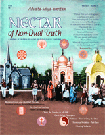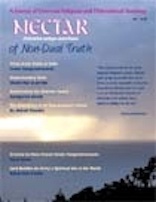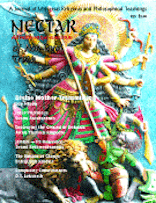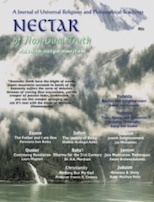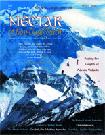4 Wisdom Facets from the Gem of Truth
Teachings from Sri Ramakrishna, Sri Sarada Devi, Swami Vivekananda and the devotees. 6 Illumined Guru and Qualified Disciple
by Swami Ranganathananda
Excerpted at President Maharaj’s suggestion from his book, Message of the Upanishads, the eternal principle of guru-disciple relationship is explored in depth, utilizing the sagacious wisdom contained in the Katho Upanishad. Therein we read that “the teacher must be ascarya, wonderful, and the student, kusala, talented, if their contact is to result in illumination.”
9 Guru-Sishya Parampara
in the Tales of Sri Ramakrishna
by Dr. Sumita Roy
The copious and sententious truisms used in all religious traditions by their saints, sages, savants and saviors, are most effective in communicating the sometimes abstruse and recondite axioms of the scriptures in a concise and cogent way. This technique was most assuredly utilized by Sri Ramakrishna Paramahamsa, who ingenuously expressed pithy apothegms and superlative stories by the hundreds in order to devolve the essence of spiritual life to others.
11 Christ, the Teacher in my Life
by Deacon Peter A. Solan
Nondualism in the Christian religion often appears in correlation to mention of the Almighty Father of whom Christ spoke. His assertion that “I and my Father are one,” for instance, is simply and profoundly an Advaitic or nondual statement of great import. In this article, Deacon Peter Solan explores another revealing teaching of the Christ, “Not my will, but Thy will,” which, when realized, attenuates the sense of individuality and renders creature and Creator one in essence.
|
13 The Goal and the Way
by Swami Aseshananda
“Renunciation is not condemnation, it is deification.” With this powerful and pellucid statement, the likes of which proceeded profusely from the lips of Swami Aseshananda continually via his lectures, the implicit nature of path, purpose and preceptor are well illustrated. The goal of spiritual life is, indeed, renunciation of all that would stand against the realization of Truth, thus necessitating the destruction of ignorance resulting in an end to suffering. 20 There is Only the One
The spiritual metaphysics of Plotinus, by Lex Hixon In his book, Coming Home, Lex Hixon states: “Plotinus writes what must be the most coherent spiritual metaphysics in Eastern or Western tradition.” This article offers insight into his thought and writings, and reveals the transmission of his guru lineage.
22 Hearing Vedanta
by Annapurna Sarada
In the second installment of this beneficial series, the definition of avidya, or ignorance, is brought forward with regards to its proper place and perspective in Eastern spiritual teachings. Hardly a mere scarcity of facts or a lack of book-learning, we find it is more associated with the mind’s proclivity to forget Reality, and thus it is at the root of suffering on all levels.
23 Stories as Scripture – Part Two
by Babaji Bob Kindler
In part two of this presentation of commentaries on the Great Master’s teachings through sayings, seven salient and sapient stories are given issuance. These terse transmissions hold within them the ability to both transform and transport the mind, bringing back its potential to access and utilize everything preconscious that is most important to it.
|

